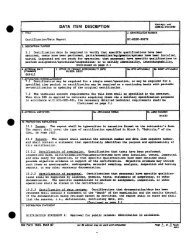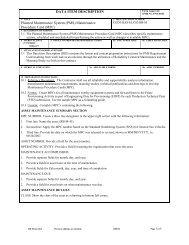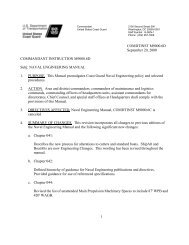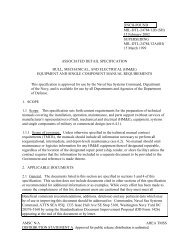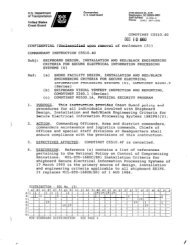comdtinst m2400.1f - US Coast Guard Response Boat-Medium
comdtinst m2400.1f - US Coast Guard Response Boat-Medium
comdtinst m2400.1f - US Coast Guard Response Boat-Medium
Create successful ePaper yourself
Turn your PDF publications into a flip-book with our unique Google optimized e-Paper software.
2.B. Distress Frequencies.<br />
1. 500 kHz: The frequency 500 kHz is an international distress and<br />
calling frequency, and is used by ships to request assistance from<br />
the maritime services using morse code. It is also used for the<br />
distress call and distress traffic, and for urgency and safety<br />
signals and urgency and safety messages. Additionally:<br />
a. 500 kHz. 500 kHz may only be used for call and reply, or by coast<br />
stations to announce their traffic lists under certain<br />
restrictions.<br />
b. Usage. With the exception of distress communications and urgency<br />
and safety signals, no transmissions will be made on 500 kHz for<br />
three minutes twice each hour beginning at HX + 15 and HX + 45<br />
UTC.<br />
c. <strong>Coast</strong> <strong>Guard</strong> Usage. <strong>Coast</strong> <strong>Guard</strong> units may (subject to<br />
limitations stated above) employ 500 kHz as follows:<br />
(1) Transmit and receive distress calls and distress<br />
traffic (using either CW or MCW emission).<br />
(2) Transmit and receive urgency and safety signals and urgency<br />
and safety traffic. (Safety messages should be transmitted<br />
on an authorized working frequency wherever possible after<br />
preliminary announcement on 500 kHz.)<br />
(3) Transmit the alarm signal when authorized (MCW must be used).<br />
(4) Establish communications with ships equipped with<br />
radiotelegraph.<br />
(5) Call <strong>Coast</strong> <strong>Guard</strong> units.<br />
(6) Announce Maritime Safety Information Broadcasts.<br />
2. 2183.4 (2182) kHz: The frequency 2183.4 (2182) kHz is the<br />
distress and calling voice frequency for the maritime mobile<br />
service. The frequency may be used by ship or aircraft<br />
radiotelephone stations to request assistance from the maritime<br />
service. It may used for distress calls and distress traffic<br />
and for urgency, safety and Emergency Position Indicating Radio<br />
Beacon (EPIRB) signals and urgency and safety messages. In addition<br />
it may be used for call and reply, for signals preparatory to<br />
traffic, and by coast radiotelephone stations to announce<br />
transmissions, on other frequencies, which are of general interest<br />
to ship stations including ordinary weather and hydrographic<br />
information. <strong>Coast</strong> <strong>Guard</strong> units may use 2183.4 (2182) kHz as follows:<br />
a. Distress. Transmit and receive distress calls and distress<br />
messages.<br />
b. Safety Messages. Transmit and receive urgency, safety and EPIRB<br />
signals and urgency and safety traffic. (Safety messages should be<br />
transmitted on an authorized working frequency wherever possible<br />
after preliminary announcement on 2183.4 (2182) kHz).<br />
2-2





